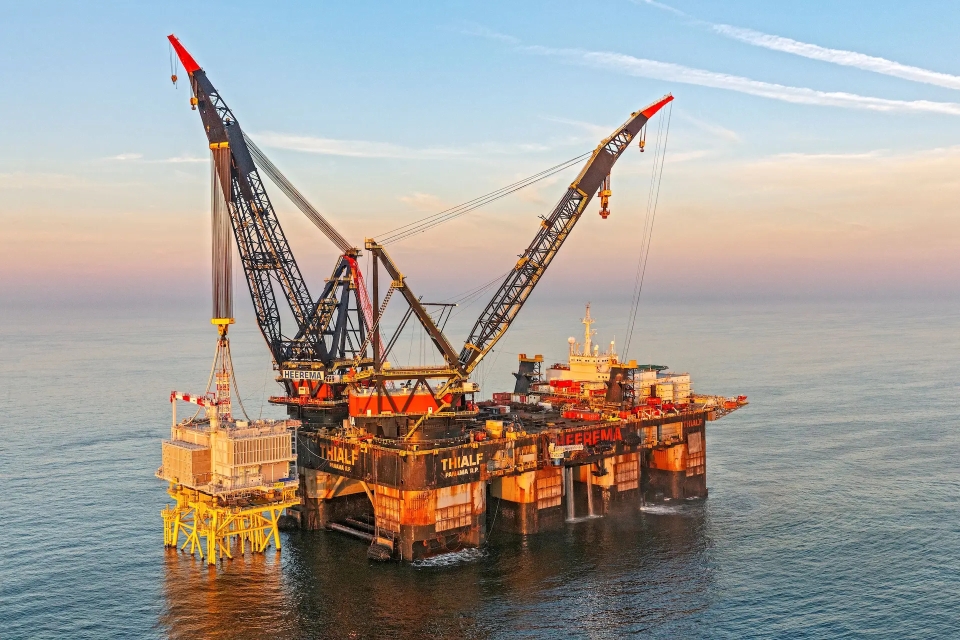With the help of Heerema Marine Contractors’ crane vessel Thialf, the superstructure (topside) for the offshore transformer platform Hollandse Kust (west Alpha) was successfully placed on the jacket. The topside is located some 50 kilometres off the coast of Egmond aan Zee.
From 2026, grid operator TenneT will bring sustainable wind energy ashore via this “socket”.
On a floating pontoon, the ready-to-use topside left the port of Antwerp on Monday, 4 September. The structure was then towed to Dutch waters via the Scheldt to sail into the North Sea at Vlissingen. The topside was built in Belgium by the Equans/Smulders contractor combination and almost two years after the first steel cut, the large steel box (over 3600 tonnes) was ready for sail out last week. Installation took place on Thursday night, 7 September.
Also read: Heerema and Allseas to install 14 offshore platforms for TenneT
Thialf
Since last year, the jacket has been firmly anchored on the seabed off the coast of Egmond aan Zee. To install the superstructure, Heerema‘s crane vessel Thialf set course for the jacket from the Norwegian port of Stavanger at the same time as the topside. After the two vessels met at sea, the pontoon moored against the Thialf. On board the crane barge, Matthijs Knollenburg, as construction manager on behalf of TenneT, closely followed the work.
Knollenburg: ‘After untying, the topside was lifted into the air by the crane vessel. The pontoon was then towed away, after which the Thialf had to sail some 500 metres towards the jacket. So-called cones are attached to the jacket. These can be compared to inverted ice cream cones, which enabled us to lower the topside exactly in the right place without too much measuring work.’
Now that the placement has been completed, a hotel ship will soon be placed next to the platform. Knollenburg: ‘After this jackup barge has extended its legs and hangs like a platform above the waves, a walkway will be suspended between the ship and the platform. A team of mechanics and technicians will then spend the next few months on the vessel to weld the topside to the jacket and take care of commissioning the installation.’
Also read: Heerema wins IMCA Award for reducing noise in piling operations
Unmanned
Earlier this year, Jan De Nul Group already installed the two sea cables that will soon bring the green power from the wind farm ashore.
‘These cables also laid the fibre-optic connection that will soon allow everything on the unmanned platform to be controlled from land,’ explains Knollenburg. ‘Inside the large steel box are, among other things, the two power transformers that raise the voltage level from 66 kilovolts to 220 kilovolts for efficient transmission of power to land. In addition, over 130 kilometres of cable also hangs in the topside to connect all the systems.’
The sea cables already in the seabed come ashore via the Heemskerk/Wijk aan Zee beach. Behind the dunes, these are linked to the cables that feed power into TenneT’s high-voltage grid some 10 kilometres away along the A9 in Beverwijk. The “socket at sea” for the wind farm will be ready before the end of this year.
Roadmap Offshore Wind Energy 2030
TenneT handles the connection of offshore wind farms to the national high-voltage grid. Earlier this year, TenneT already completed the Offshore Wind Energy Roadmap 2023. This realised 4.5 GW of installed capacity of offshore wind farms.
The connection of the Hollandse Kust west Alpha wind farm is the first of the Roadmap Offshore Wind Energy 2030 (Routekaart Windenergie op zee 2030). This roadmap aims to realise around 21 GW of installed capacity of offshore wind energy around 2030.
Picture by TenneT.
Also read: In pictures: Heerema installs 24 turbines using floating installation method








